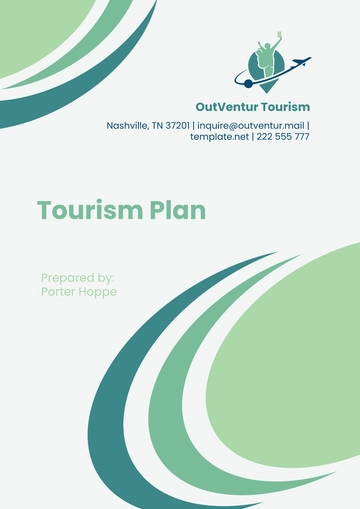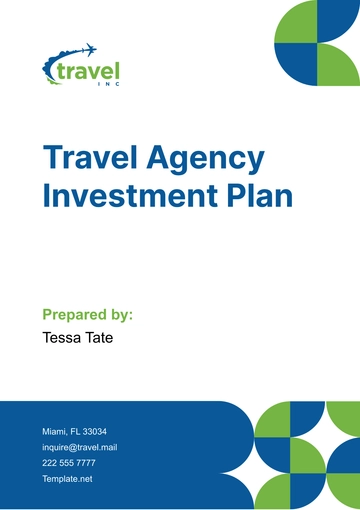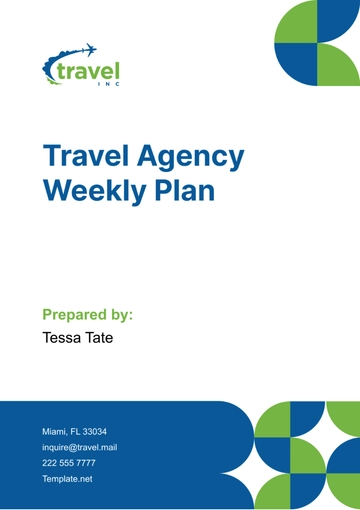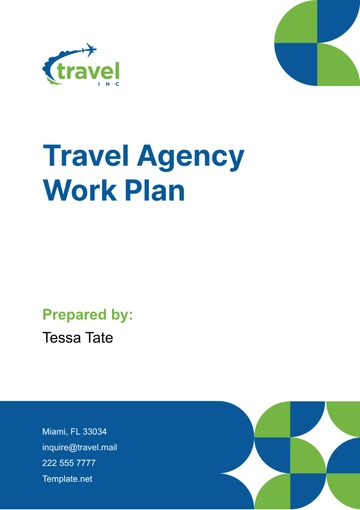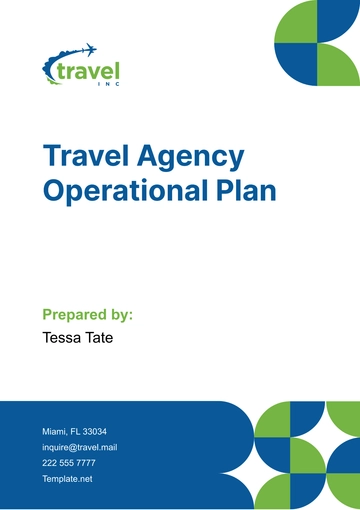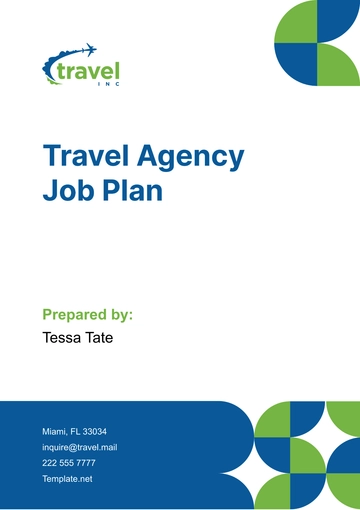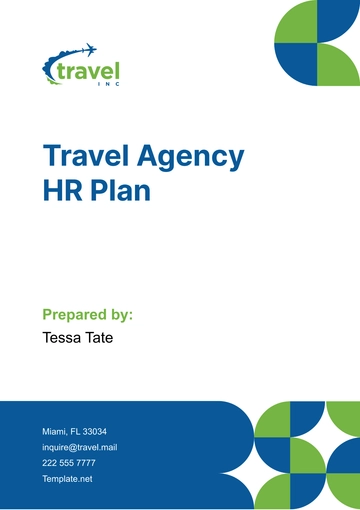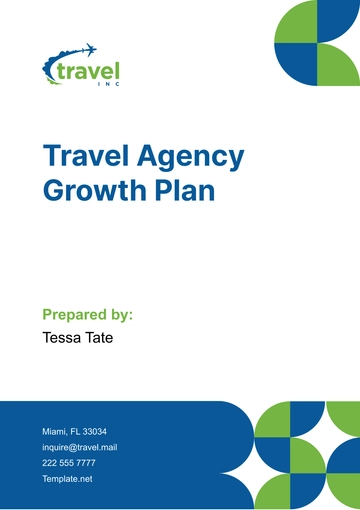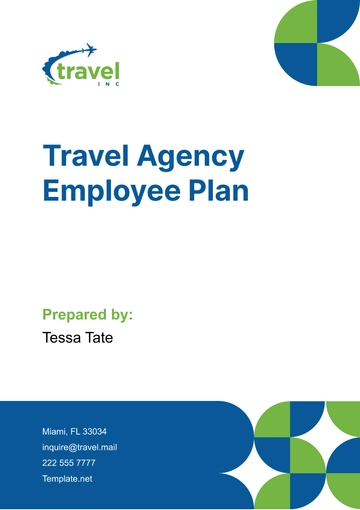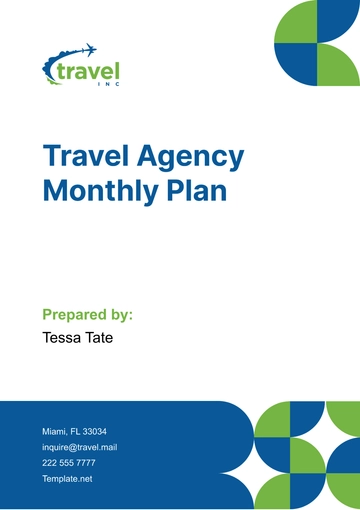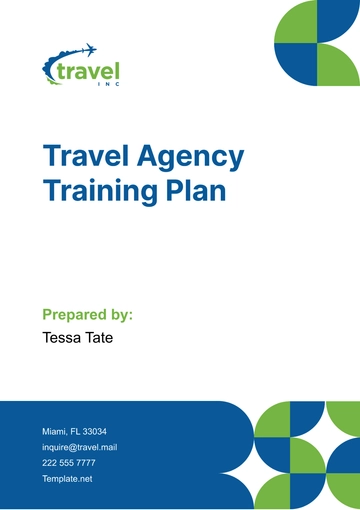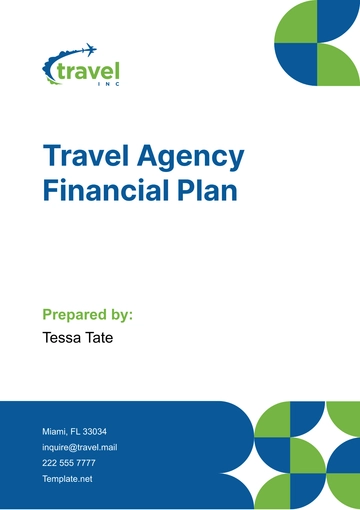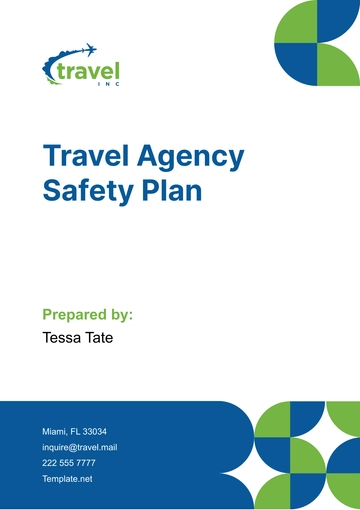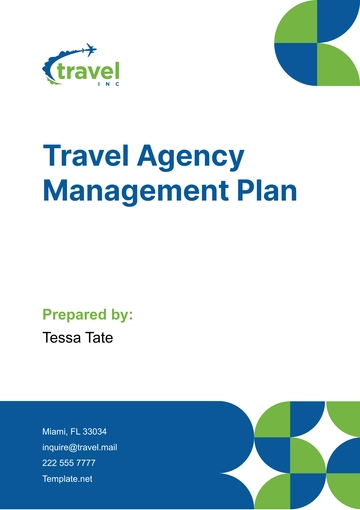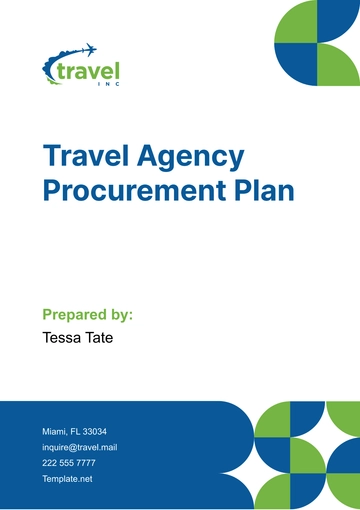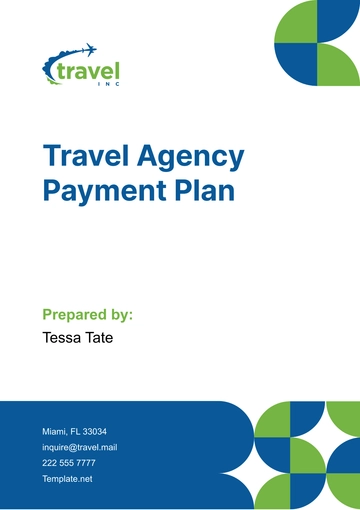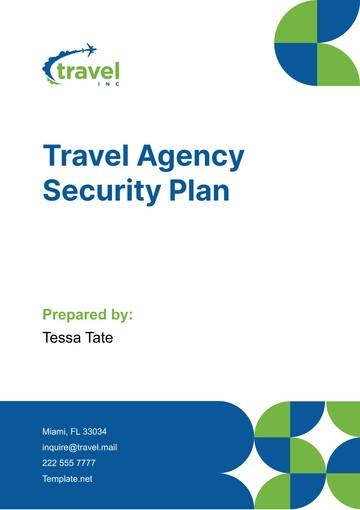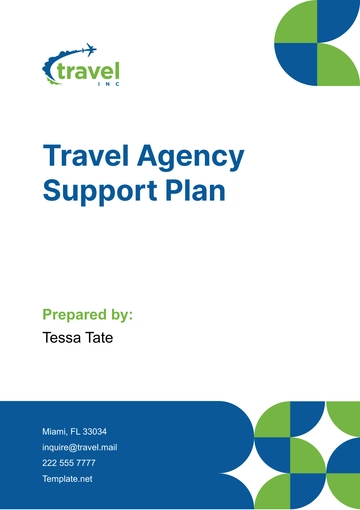Free Travel Agency Work Plan
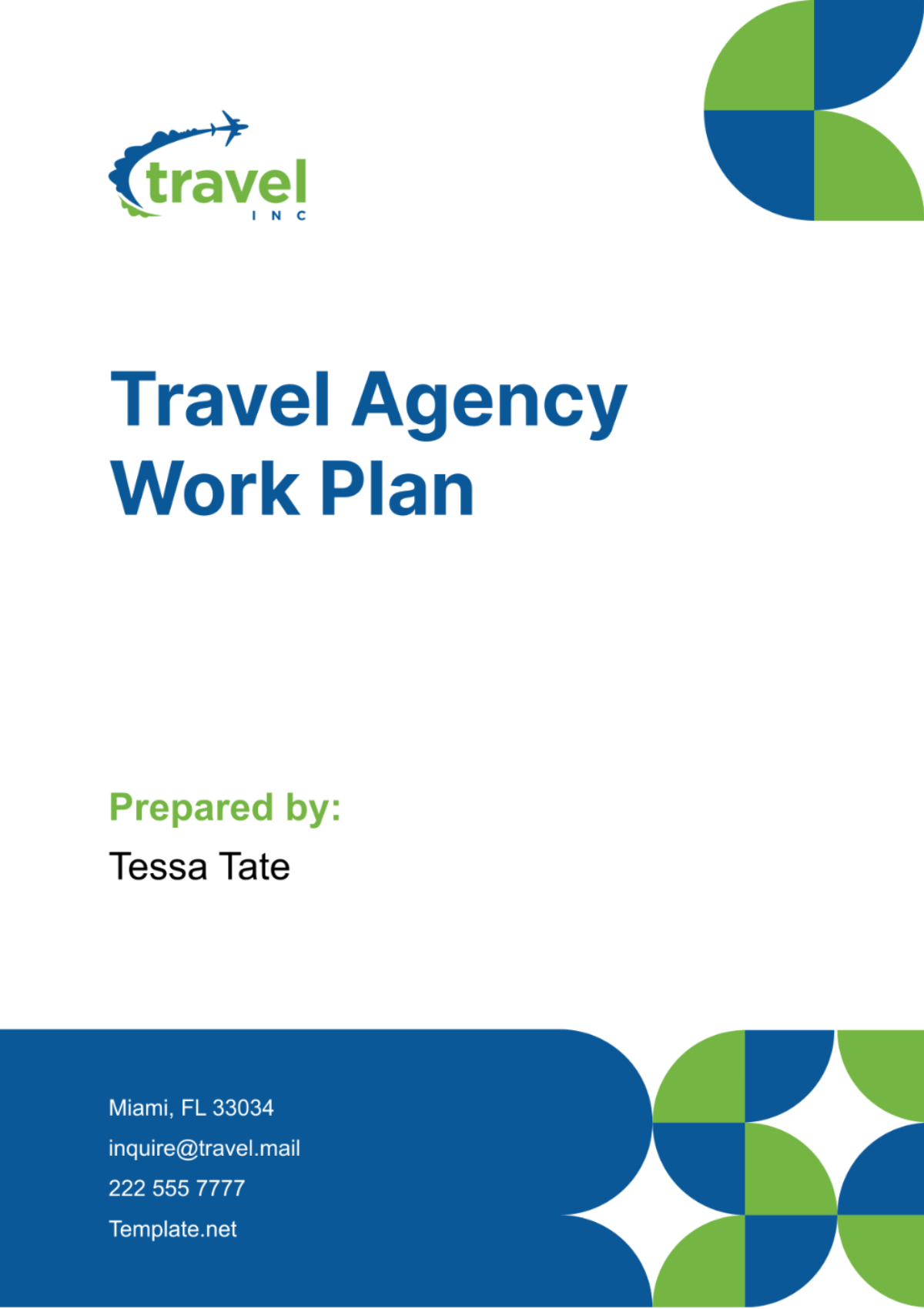
I. Executive Summary
A. Overview of the Travel Agency
Our travel agency, [Your Company Name], specializes in providing customized travel experiences to adventurous travelers seeking unique and immersive journeys around the world. With a team of passionate travel experts and a commitment to exceptional service, we aim to create unforgettable memories for our clients.
B. Summary of Key Objectives
Our primary objectives for the upcoming year include:
Increase sales revenue by 20% through targeted marketing campaigns and strategic partnerships.
Enhance customer satisfaction by implementing personalized service enhancements and streamlined booking processes.
Expand our market reach by tapping into new demographics and geographic regions.
C. Highlights of Strategies and Actions
Develop comprehensive marketing campaigns targeting adventure enthusiasts through social media, email marketing, and influencer collaborations.
Enhance our product offerings with unique travel experiences tailored to niche markets such as eco-tourism and cultural immersion.
Invest in staff training and technology upgrades to improve operational efficiency and customer service.
II. Introduction
A. Background of the Travel Agency
Founded in [Year], [Your Company Name] has quickly become a leading provider of adventure travel experiences, known for our commitment to excellence and innovation in the industry. Our team of travel experts brings a wealth of knowledge and expertise to create bespoke itineraries that exceed our clients' expectations.
B. Purpose and Scope of the Work Plan
The purpose of this work plan is to outline our strategic initiatives and operational goals for the upcoming year, with a focus on driving growth, enhancing customer satisfaction, and optimizing our internal processes. This plan will serve as a roadmap to guide our actions and ensure alignment with our overarching business objectives.
C. Key Stakeholders and Contributors
Key stakeholders involved in the development and implementation of this work plan include executive leadership, department heads, marketing and sales teams, customer service representatives, and operational staff. Collaboration and communication among these stakeholders will be essential for the successful execution of our strategies.
III. Market Analysis
A. Current Trends in the Travel Industry
Recent trends indicate a shift towards experiential travel, with travelers seeking authentic cultural encounters and immersive experiences off the beaten path. This trend aligns with [Your Company Name]' focus on crafting personalized itineraries tailored to individual interests and preferences.
Sustainable tourism practices are gaining traction, with an increasing number of travelers prioritizing eco-friendly accommodations, responsible wildlife encounters, and carbon-neutral transportation options. [Your Company Name] is well-positioned to capitalize on this trend by offering sustainable travel experiences that minimize environmental impact while maximizing cultural immersion.
B. Analysis of Competitors
Competitor analysis reveals that while several players offer adventure travel experiences, few specialize in bespoke, personalized itineraries like [Your Company Name]. By differentiating ourselves through our commitment to tailor-made experiences and exceptional service, we can carve out a unique niche in the market.
Key competitors include established tour operators and online travel agencies catering to similar target demographics. To stay ahead of the competition, [Your Company Name] will continuously monitor competitor offerings and adapt our strategies to meet evolving customer needs and preferences.
C. Identification of Target Audience
Our target audience comprises adventurous travelers seeking immersive, off-the-beaten-path experiences that allow them to connect with local cultures and landscapes. Demographics include millennials and Gen Xers with disposable income and a desire for authentic cultural encounters that go beyond typical tourist attractions.
Geographic regions of focus include North America, Europe, and Australasia, where there is a high concentration of travelers with an appetite for adventure and exploration. By tailoring our marketing efforts to resonate with these specific demographics and regions, we can effectively reach and engage our target audience.
D. Assessment of Opportunities and Threats
Opportunities: Growing interest in adventure travel presents a significant opportunity for [Your Company Name] to expand our market reach and attract new customers. Additionally, advancements in technology, such as virtual reality tours and online booking platforms, offer innovative ways to enhance the customer experience and differentiate our brand.
Threats: Economic downturns impacting discretionary spending could potentially reduce demand for luxury travel experiences, posing a risk to our revenue growth. Geopolitical instability in popular travel destinations may also disrupt travel plans and deter potential customers. To mitigate these threats, [Your Company Name] will maintain flexibility in our offerings and closely monitor global developments that may impact travel trends.
IV. Business Objectives
A. Specific, Measurable Goals
Increase sales revenue by 20% compared to the previous year by leveraging targeted marketing campaigns and strategic partnerships.
Achieve a customer satisfaction rating of 90% or higher based on post-travel surveys by enhancing our customer service processes and implementing personalized service enhancements.
Expand our client base by acquiring 500 new customers within the target demographics through targeted outreach efforts and referral programs.
B. Timeline for Achieving Objectives
Quarterly reviews will be conducted to track progress towards each objective and make adjustments as needed to stay on track.
Year-end assessment will measure overall achievement against set targets and inform strategic planning for the following year.
C. Key Performance Indicators (KPIs)
Sales revenue growth rate will be measured quarterly to assess the effectiveness of our marketing and sales efforts.
Customer retention rate will be monitored to gauge the success of our customer service initiatives in fostering long-term relationships with clients.
Net promoter score (NPS) will be surveyed regularly to evaluate customer satisfaction and identify areas for improvement in our products and services.
Number of new customer acquisitions will be tracked to evaluate the effectiveness of our marketing campaigns and lead generation strategies in expanding our client base.
V. Marketing Strategies
A. Branding and Positioning
Emphasize [Your Company Name]' commitment to personalized, authentic travel experiences through compelling storytelling and visual imagery that showcase the unique destinations and cultural encounters our clients can expect.
Position the brand as a trusted authority in adventure travel by sharing expertise through thought leadership content, such as blog posts, podcasts, and webinars, that offer valuable insights and tips for travelers seeking off-the-beaten-path experiences.
B. Digital Marketing Channels
Leverage social media platforms such as Instagram and Facebook to showcase destination highlights, customer testimonials, and behind-the-scenes content that inspire and engage our audience.
Implement targeted email marketing campaigns segmented by traveler interests and preferences to deliver personalized recommendations and exclusive offers that resonate with each customer segment.
C. Traditional Marketing Channels
Explore partnerships with travel influencers and bloggers who align with [Your Company Name]' brand values and target demographics to reach new audiences and generate authentic endorsements of our travel experiences.
Participate in industry events and trade shows to network with potential clients and industry stakeholders, showcase our expertise, and establish [Your Company Name] as a leading provider of adventure travel experiences.
D. Partnerships and Collaborations
Forge partnerships with eco-lodges, local guides, and sustainable tourism organizations in our destination markets to offer unique, eco-friendly travel experiences that align with [Your Company Name]' commitment to responsible tourism practices.
Collaborate with travel agencies specializing in complementary services, such as adventure gear rentals or travel insurance, to create bundled packages that provide added value to our customers and streamline the booking process.
E. Promotional Campaigns and Offers
Launch seasonal promotions and limited-time offers that leverage peak travel periods and special events to incentivize bookings and drive revenue growth.
Implement a referral program that rewards existing customers for referring new clients to [Your Company Name], encouraging word-of-mouth marketing and fostering loyalty among our client base.
VI. Product Offerings
A. Overview of Travel Packages and Services
[Your Company Name] offers a wide range of travel packages and services tailored to adventurous travelers seeking immersive, off-the-beaten-path experiences around the world.
Our offerings include guided tours, customized itineraries, adventure cruises, wildlife safaris, cultural immersions, and eco-friendly accommodations, curated to showcase the diverse landscapes, cultures, and wildlife of each destination.
B. Pricing Strategy
Pricing for our travel packages and services is competitive yet reflective of the value and quality we provide, ensuring that our offerings remain accessible to our target audience while also sustaining our business operations.
We offer transparent pricing with no hidden fees, providing clarity and peace of mind to our customers throughout the booking process and beyond.
C. Unique Selling Proposition (USP)
[Your Company Name]' unique selling proposition lies in our ability to create personalized, authentic travel experiences that cater to the individual interests and preferences of each client.
Unlike mass-market tour operators, we prioritize quality over quantity, focusing on small-group experiences led by expert guides who share their passion and knowledge to enhance our clients' travel experiences.
D. Special Features and Amenities
In addition to our core travel packages and services, [Your Company Name] offers a range of special features and amenities designed to enhance our clients' comfort, convenience, and enjoyment during their travels.
These may include exclusive access to remote destinations, immersive cultural experiences, luxury accommodations, gourmet dining options, and unique activities such as wildlife encounters, hiking expeditions, and cultural workshops.
VII. Sales Tactics
A. Lead Generation Strategies
[Your Company Name] will utilize a multi-channel approach to generate leads, including targeted digital advertising campaigns on platforms like Facebook and Instagram, content marketing through our blog and social media channels, and strategic partnerships with complementary businesses and organizations. By identifying and engaging with potential customers who have expressed interest in adventure travel, we aim to build a robust pipeline of qualified leads for our sales team to nurture and convert into bookings.
B. Conversion Tactics
Our website and booking platform will be optimized for conversion, with clear calls-to-action, user-friendly navigation, and persuasive content that highlights the unique value proposition of our travel experiences. Additionally, our sales team will undergo training in consultative selling techniques, enabling them to effectively address customer needs, overcome objections, and guide prospects through the booking process with confidence and professionalism.
C. Sales Training and Development
[Your Company Name] is committed to investing in the continuous learning and development of our sales team, providing ongoing training workshops, coaching sessions, and resources to enhance their product knowledge, sales skills, and customer service excellence. By equipping our sales professionals with the tools and support they need to succeed, we aim to empower them to deliver exceptional service and drive revenue growth for the company.
D. Pricing and Revenue Management
Our pricing strategy will be informed by data-driven insights and market analysis, allowing us to set competitive yet profitable prices that reflect the value of our travel experiences. Through dynamic pricing techniques and revenue management practices, we will optimize pricing and inventory allocation to maximize revenue and yield while ensuring price integrity and customer satisfaction.
VIII. Customer Service Plan
A. Pre-Travel Assistance
[Your Company Name] will offer personalized assistance to customers during the pre-travel phase, helping them research destinations, select suitable travel packages, and customize their itineraries based on their preferences and interests. By providing expert guidance and resources, we aim to empower our customers to make informed decisions and feel confident about their travel plans.
B. During-Travel Support
Our commitment to exceptional customer service extends throughout our customers' journeys, with round-the-clock support and assistance available to address any issues, concerns, or emergencies that may arise. Whether it's a flight delay, a missed connection, or a change in itinerary, our dedicated support team will be on hand to provide timely assistance and ensure our customers' safety and satisfaction.
C. Post-Travel Follow-Up
Following the completion of their travels, [Your Company Name] will conduct post-travel surveys and feedback sessions to gather insights, evaluate customer satisfaction, and identify opportunities for improvement. By actively seeking feedback and listening to our customers' experiences, we can continually refine and enhance our products, services, and customer experiences to better meet their needs and expectations.
D. Complaint Resolution Process
In the event of a customer complaint or issue, [Your Company Name] will follow a clear and transparent resolution process, with designated points of contact, escalation procedures, and resolution timelines in place. By prioritizing prompt and effective resolution of customer concerns, we aim to uphold our reputation for excellence in customer service and maintain the trust and loyalty of our clientele.
E. Feedback Collection Mechanisms
To ensure we capture a comprehensive range of customer feedback, [Your Company Name] will implement multiple feedback collection mechanisms, including online surveys, email inquiries, social media listening, and direct customer engagement. By regularly analyzing and reviewing customer feedback data, we can gain valuable insights into our customers' preferences, expectations, and satisfaction levels, enabling us to make informed decisions and drive continuous improvement across our operations and service offerings.
IX. Operational Plan
A. Staffing Requirements
[Your Company Name] will assess current staffing levels and skills to ensure we have the right talent in place to support our business objectives. We will invest in recruitment, training, and retention strategies to attract and retain top talent across all departments, from sales and marketing to operations and customer service.
B. Office Management Procedures
Our office management procedures will focus on creating an efficient and collaborative work environment that supports productivity and teamwork. We will implement systems and protocols for task delegation, communication, and project management to streamline workflows and optimize resource allocation.
C. Technology Infrastructure
[Your Company Name] will invest in technology upgrades and infrastructure improvements to enhance our operational efficiency and customer service capabilities. This may include upgrading our booking and reservation systems, implementing customer relationship management (CRM) software, and integrating digital tools for communication and collaboration.
D. Administrative Processes and Systems
We will review and streamline our administrative processes and systems to eliminate inefficiencies and reduce administrative overhead. This may involve automating repetitive tasks, digitizing paperwork, and standardizing procedures to improve accuracy, consistency, and compliance across our operations.
X. Financial Projections
A. Revenue Forecast
[Your Company Name] will develop revenue forecasts based on projected sales volumes, pricing strategies, and market trends. We will monitor key performance indicators such as sales revenue growth rate, average transaction value, and customer acquisition cost to track our progress and adjust our strategies as needed.
B. Expense Budget
Our expense budget will outline anticipated costs across various categories, including marketing and advertising, personnel, technology, operations, and overhead. We will prioritize investments that support our growth objectives while maintaining financial discipline and ensuring cost-effectiveness in our operations.
C. Profitability Analysis
[Your Company Name] will conduct regular profitability analysis to assess the financial health of our business and identify opportunities for optimization and improvement. We will calculate key metrics such as gross profit margin, net profit margin, and return on investment to evaluate the effectiveness of our strategies and make data-driven decisions to drive profitability.
D. Contingency Planning
In addition to our financial projections, we will develop contingency plans to mitigate risks and uncertainties that may impact our business operations. This may include strategies for managing cash flow fluctuations, responding to external shocks such as economic downturns or natural disasters, and diversifying revenue streams to reduce reliance on any single source of income.
XI. Monitoring and Evaluation
A. Metrics for Tracking Progress
[Your Company Name] will establish key performance indicators (KPIs) to monitor progress towards our business objectives and track the effectiveness of our strategies. This may include metrics such as sales revenue, customer satisfaction scores, website traffic, conversion rates, and operational efficiency measures.
B. Regular Review and Reporting Schedule
We will implement a regular review and reporting schedule to assess our performance against established KPIs and milestones. This may involve monthly, quarterly, and annual reviews, as well as ad hoc assessments as needed to address specific issues or opportunities.
C. Process for Making Adjustments
[Your Company Name] will maintain flexibility in our planning and decision-making processes to adapt to changing market conditions and emerging trends. We will conduct regular reviews of our strategies and performance data to identify areas for improvement and make adjustments as needed to optimize our outcomes.
D. Continuous Improvement Initiatives
Our commitment to continuous improvement will drive ongoing innovation and refinement across all aspects of our business. We will encourage feedback and collaboration among our team members, customers, and partners to identify opportunities for innovation, efficiency gains, and service enhancements that will enable us to stay ahead of the competition and deliver exceptional value to our stakeholders.
- 100% Customizable, free editor
- Access 1 Million+ Templates, photo’s & graphics
- Download or share as a template
- Click and replace photos, graphics, text, backgrounds
- Resize, crop, AI write & more
- Access advanced editor
Manage your travel agency's growth effectively with the Travel Agency Work Plan Template from Template.net. This editable and customizable template, equipped with an intuitive AI Editor Tool, streamlines your strategic planning process. Craft tailored marketing strategies, optimize operational efficiency, and achieve your business objectives with ease. Elevate your agency's success with this comprehensive and user-friendly template.
You may also like
- Finance Plan
- Construction Plan
- Sales Plan
- Development Plan
- Career Plan
- Budget Plan
- HR Plan
- Education Plan
- Transition Plan
- Work Plan
- Training Plan
- Communication Plan
- Operation Plan
- Health And Safety Plan
- Strategy Plan
- Professional Development Plan
- Advertising Plan
- Risk Management Plan
- Restaurant Plan
- School Plan
- Nursing Home Patient Care Plan
- Nursing Care Plan
- Plan Event
- Startup Plan
- Social Media Plan
- Staffing Plan
- Annual Plan
- Content Plan
- Payment Plan
- Implementation Plan
- Hotel Plan
- Workout Plan
- Accounting Plan
- Campaign Plan
- Essay Plan
- 30 60 90 Day Plan
- Research Plan
- Recruitment Plan
- 90 Day Plan
- Quarterly Plan
- Emergency Plan
- 5 Year Plan
- Gym Plan
- Personal Plan
- IT and Software Plan
- Treatment Plan
- Real Estate Plan
- Law Firm Plan
- Healthcare Plan
- Improvement Plan
- Media Plan
- 5 Year Business Plan
- Learning Plan
- Marketing Campaign Plan
- Travel Agency Plan
- Cleaning Services Plan
- Interior Design Plan
- Performance Plan
- PR Plan
- Birth Plan
- Life Plan
- SEO Plan
- Disaster Recovery Plan
- Continuity Plan
- Launch Plan
- Legal Plan
- Behavior Plan
- Performance Improvement Plan
- Salon Plan
- Security Plan
- Security Management Plan
- Employee Development Plan
- Quality Plan
- Service Improvement Plan
- Growth Plan
- Incident Response Plan
- Basketball Plan
- Emergency Action Plan
- Product Launch Plan
- Spa Plan
- Employee Training Plan
- Data Analysis Plan
- Employee Action Plan
- Territory Plan
- Audit Plan
- Classroom Plan
- Activity Plan
- Parenting Plan
- Care Plan
- Project Execution Plan
- Exercise Plan
- Internship Plan
- Software Development Plan
- Continuous Improvement Plan
- Leave Plan
- 90 Day Sales Plan
- Advertising Agency Plan
- Employee Transition Plan
- Smart Action Plan
- Workplace Safety Plan
- Behavior Change Plan
- Contingency Plan
- Continuity of Operations Plan
- Health Plan
- Quality Control Plan
- Self Plan
- Sports Development Plan
- Change Management Plan
- Ecommerce Plan
- Personal Financial Plan
- Process Improvement Plan
- 30-60-90 Day Sales Plan
- Crisis Management Plan
- Engagement Plan
- Execution Plan
- Pandemic Plan
- Quality Assurance Plan
- Service Continuity Plan
- Agile Project Plan
- Fundraising Plan
- Job Transition Plan
- Asset Maintenance Plan
- Maintenance Plan
- Software Test Plan
- Staff Training and Development Plan
- 3 Year Plan
- Brand Activation Plan
- Release Plan
- Resource Plan
- Risk Mitigation Plan
- Teacher Plan
- 30 60 90 Day Plan for New Manager
- Food Safety Plan
- Food Truck Plan
- Hiring Plan
- Quality Management Plan
- Wellness Plan
- Behavior Intervention Plan
- Bonus Plan
- Investment Plan
- Maternity Leave Plan
- Pandemic Response Plan
- Succession Planning
- Coaching Plan
- Configuration Management Plan
- Remote Work Plan
- Self Care Plan
- Teaching Plan
- 100-Day Plan
- HACCP Plan
- Student Plan
- Sustainability Plan
- 30 60 90 Day Plan for Interview
- Access Plan
- Site Specific Safety Plan
